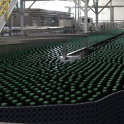plester1 posted:Carbonic acid is a diprotic acid that can act as a buffer. Yes it's an acid, but that just means its pH is less than 7; it likes to sit at pH 5.7 or around that neighborhood. The instructions for Star San say its good as long as it's pH is below 3. I would not keep Star San under CO2. I don't think the buffering capability of carbonic acid is enough to stop starsan from getting to a low enough pH to sanitize things.
|
|
|
|
|

|
| # ? Apr 19, 2024 08:27 |
|
Josh Wow posted:Edit: Just dropped $40 on candi syrup Just in case anyone is on a budget out there, you can make 5 pounds of candy syrup for $3 if you already have a thermometer, which you all surely do.
|
|
|
|
My lager's been fermenting for 11 days now and it's only dropped about 14 gravity points. I did two 2L stirplate starter steps for this yeast and it looked pretty healthy throughout, I don't know what happened. Something's definitely wrong  I warmed up to 58* to give it some help. Maybe I just got a bad... I don't know what. It looked good in the flask. gently caress. I warmed up to 58* to give it some help. Maybe I just got a bad... I don't know what. It looked good in the flask. gently caress.
|
|
|
|
tesilential posted:Just in case anyone is on a budget out there, you can make 5 pounds of candy syrup for $3 if you already have a thermometer, which you all surely do. Thats not how the candi syrup makers mentioned in this thread make candi syrup, in fact pretty much not possible to make candi syrup like those guys do at home. Email the https://www.candisyrup.com guys if you want some details, here is an excerpt from HBT where I first started chatting with the guy. quote:Just as an insight from our tests, Randy Mosher's recipe is not an authentic, (nor a close approximation), Candi Syrup. Early on, we tried his and other permutations on the web and in print. All fail to match "authentic" Candi Syrup based on our use of gas chromatography throughout our due diligence to baseline the recipe(s). If you read the entire thread on this subject you'll note my partner is a Food Chemist. We've been trialing methods and materials for just over a year and have duplicated, (and in the opinion of some more than exceeded), the quality of the import syrups. Refined or unrefined sugars from Jaggary to Turbinado to Demerara, Beet, Cane, make no difference whatsoever. The complexity does not originate in the level of refined sucrose or lack of it or the origin of the sucrose, (Beet or Cane). If you are after a "rummy" affect then just use Sorghum. It's cheaper. If you're after something a little more complex then you'll need to use a more complex syrup. I think brewers, (including me), want the very best result from a Belgian Ale recipe. If you're interested in quality syrups and the science behind them you may look at the following volumes to give you a more empirical perspective on food flavor, especially the sections on sugars: Candi syrup is serious business
|
|
|
|
rage-saq posted:
This is the conclusion I came to as well. I wanted to make my own but everything I read said it wouldn't be close to what actual belgian breweries use. Ditto for other professional manufacturers, like the northern brewer syrup with the bad reviews.
|
|
|
|
From what I read, Candi syrup is pretty much just invert sugar. We make it at work for Gelato, invert sugar is made pretty much the same way as candy but without stirring. Stirring the pot will create crystals, which creates 'candy' but when there is no jarring movement the sucrose bonds so there is nothing for them to grasp onto; making this clear to dark slurry. Reading over the wiki page on inverted sugar, it seems adding acid to accelerate this change is common, but I know at work we pretty much just put a pot of evaporated cane juice (our sugar of choice) on the stove, don't touch it until it hits boiling and then let it sit. I assume then belgian candi syrup is just 'more boiled' depending on the 'L'? Same thing or not the same? *beating a dead horse itt* Jacobey000 fucked around with this message at 13:51 on Oct 7, 2011 |
|
|
|
indigi posted:My lager's been fermenting for 11 days now and it's only dropped about 14 gravity points. I did two 2L stirplate starter steps for this yeast and it looked pretty healthy throughout, I don't know what happened. Something's definitely wrong It varies by yeast strain, but lagers are just slow. It took my pilsner about 3 weeks just to drop from 1.051 to 1.020 at 50 degrees. Then I raised the temp to about 60-62 for 3 days and it quickly chugged down the rest of the way to 1.012. Heck it took like 3 days just to develop a visible kreusen and start bubbling, and I pitched 2 vials into a 2L stirplate starter. Forget about it for another week or two before you worry.
|
|
|
|
The guy who runs candisyrup.com has a vested interest in telling you the only "authentic" product is going to come from you paying him money
|
|
|
|
mewse posted:The guy who runs candisyrup.com has a vested interest in telling you the only "authentic" product is going to come from you paying him money Definitely. Ironically, last winter the main candi sugar supplier to homebrewers (maybe the guy Rage quoted?) had recipes for how to make their product at home if you were cheap and industrious. From BLAM there are many type of dark sugar syrup. The Belgians use beet sugar and water and boil it until they reach the desired color and taste profile. Sucrose (cane and beet sugar) breaks down into glucose and fructose. If you exceed 290*f both the glucose and fructose caramelize and are no longer sugars. This means the yeast can't digest them. Westvletren is suspected to use caramelized syrup in addition to dark candy sugar to get that burnt taste. In America, suppliers use some acid as a catalyst to breakdown sucrose into it's two parts faster. Candy sugar is definitely a serious business, but it's one of the first things a dessert chef learns to make. E: VVV drat you!VVV tesilential fucked around with this message at 16:10 on Oct 7, 2011 |
|
|
|
tesilential posted:Candy sugar is definitely a serious business, but it's one of the first things a desert chef learns to make. What about chefs from the rainforest? I know sugar is hygroscopic - are you saying it's not worth trying in a humid climate? vvv Spelling pedantry ITT! Jo3sh fucked around with this message at 16:23 on Oct 7, 2011 |
|
|
|
Jo3sh posted:What about chefs from the rainforest? I know sugar is hygroscopic - are you saying it's not worth trying in a humid climate? Booooooooooooooooooooooo
|
|
|
|
I have a question and I realize it's a really broad question but I'm just looking for a base point to start from. Unfortunately I forgot the recipe I want to modify at home so I can't give details. Is there an average quantity adjustment you'd use for exchanging hop pellets/plugs for fresh (even if frozen)? I came into some cascade and chinook hops I want to use. I know chinook is extremely bitter and probably only fit for IPAs, but the cascade I'd like to use as a dryhopper. Unfortunately for my particular use I'm not even swapping cascade pellets for fresh cascade, I think it used Saaz but I can put up quantities/types when I get home hopefully. I'm FAIRLY certain there were two 1oz plugs put in for dry hopping in the kit... edit: this is pretty much the recipe, but the honey addition this guy did himself, it wasn't part of the kit http://brewkettle.blogspot.com/2007/07/fenway-golden-ale.html Morbid Florist fucked around with this message at 17:25 on Oct 7, 2011 |
|
|
|
Here's some Aajarg posted:A brief history of sugar
|
|
|
|
I just found 9lbs of milled Vienna malt sitting in my unused picnic cooler; Its probably a few months old but it the cooler was sealed and the grain is bagged. I gave it a smell and it didn't seem rotten or anything, should I make a brew with it or toss it?
|
|
|
|
Morbid Florist posted:Is there an average quantity adjustment you'd use for exchanging hop pellets/plugs for fresh (even if frozen)? I came into some cascade and chinook hops I want to use. I know chinook is extremely bitter and probably only fit for IPAs, but the cascade I'd like to use as a dryhopper. Based on a few seconds of random googling, you get about 10% more bitterness out of pellets than you do out of whole. So a 50 IBU recipe with whole would yield 55 IBU's with pellet etc. j3rkstore posted:I just found 9lbs of milled Vienna malt sitting in my unused picnic cooler; Its probably a few months old but it the cooler was sealed and the grain is bagged. I gave it a smell and it didn't seem rotten or anything, should I make a brew with it or toss it? If it looks, smells and tastes good use that poo poo.
|
|
|
|
Docjowles posted:Based on a few seconds of random googling, you get about 10% more bitterness out of pellets than you do out of whole. So a 50 IBU recipe with whole would yield 55 IBU's with pellet etc. No poo poo. I thought I'd read that I'd need more fresh but the amount could vary depending on form. Now to start figuring out what I'd want to use to substitute kent goldings for cascades...
|
|
|
|
Morbid Florist posted:No poo poo. I thought I'd read that I'd need more fresh but the amount could vary depending on form. Now to start figuring out what I'd want to use to substitute kent goldings for cascades... If by "fresh" you mean just harvested, not dried, "wet," then yes, you'll need more than for dry hops. Lots more. 5x the weight is the rule of thumb, I think.
|
|
|
|
Josh Wow posted:This is the conclusion I came to as well. I wanted to make my own but everything I read said it wouldn't be close to what actual belgian breweries use. Ditto for other professional manufacturers, like the northern brewer syrup with the bad reviews. I've tried making my own several times but I don't even bother now. The difference in flavor quality between what DSI/CSI makes and what I've come up with like orders of magnitude, they aren't even like the same idea. I think some of the secrets that makes these guys stuff so good is probably related to pressure cooking and other things to control the water levels and other stuff. The CSI guy told me that they underwent over 200 trial batch productions before they thought they were getting very good and each trial batch used like 100lbs of sugar. He's a pretty cool guy, I bet he would respond to some non-proprietary related questions if you were to email him.
|
|
|
|
What about roasting your own brown malt? The shop didn't have the stuff, so I put some 2-row in the oven, following instructions I found online. But of course, I have no idea if what I got is close to the stuff I would buy, and I have no taste comparison I can make.
|
|
|
|
Jo3sh posted:If by "fresh" you mean just harvested, not dried, "wet," then yes, you'll need more than for dry hops. Lots more. 5x the weight is the rule of thumb, I think. Ah now we're getting into what I suspected might be a problem. I got these from someone via someone else. I know he grew them and froze them. I don't know if they were dried or not. Is it common for people to freeze them without drying them first? I know everyone's different but I don't know if there's a general rule of thumb people would try and follow if they're THIS into brewing beer that they'd grow their own hops.
|
|
|
|
Docjowles posted:If it looks, smells and tastes good use that poo poo. Second. Make sure you taste it - if it tastes or reminds you of the consistency of stale chips, I'd say trash it. Crush up some fresh malt (if you can) to compare. It might smell ok but chew and taste old.
|
|
|
|
http://www.homedepot.com/h_d1/N-5yc1v/R-202090128/h_d2/ProductDisplay?langId=-1&storeId=10051&catalogId=10053&superSkuId=202939027 Would something like this work for removing/replacing the door shelving from a minifridge? I can make my 3 gallon better bottle fit without taking them out, but the door is pressing on it and tilting it. Using a 12 pack of soda to keep the door from springing open. Ghetto fabulous!
|
|
|
|
Regarding making your own candi syrup or brown malt, together with growing your own hops, malting your own barley, or anything else where you make an ingredient you might otherwise buy: If your goal is consistency, matching a commercial beer, or brewing on style, the commercial product is almost always the superior choice. On the other hand, there's no reason to avoid trying new things if your goal is to make tasty beer that might not match any particular example. It's the spirit of homebrewing taken to another remove. There's absolutely nothing wrong with either approach. Rage-saq buys his syrup because he likes the results and finds that he can't get the particular flavor he wants by making it himself. Testilential makes his own because he likes the results, and probably also enjoys the process of making the syrup and the cost savings. So either way, brew what you like, how you like.
|
|
|
|
beetlo posted:http://www.homedepot.com/h_d1/N-5yc1v/R-202090128/h_d2/ProductDisplay?langId=-1&storeId=10051&catalogId=10053&superSkuId=202939027 Well gently caress it doesn't matter what material I buy. Good ole Haier GLUED the shelves to the door. And not just around the edges. It's glued to the insulation too, it seems. I mean, I'm sure I could keep prying until it comes off, but I'll most likely destroy the shelves and probably damage the door in the process. LAME. Edit: I just realized it doesn't have to look good in there. Redneck engineering away! Hacked the 2 offending shelves off with a utility knife and a hacksaw. Taped over the bare insulation areas with duct tape. Good to go. beetlo fucked around with this message at 02:56 on Oct 8, 2011 |
|
|
|
Got my homemade stir plate built!
Huge_Midget fucked around with this message at 03:29 on Oct 8, 2011 |
|
|
|
Does anyone here know much about using fruit (specifically frozen blueberries) in beer? I have a few questions: Do I need to worry about yeast/bacteria on the blueberries? (does freezing kill them?) Should I mush them up before I add them? How do people normally add them, I havent bothered with a secondary for years so was thinking I would mush them up and dump them in once fermentation is finished or almost finished, might end up blocking the tap when I try and get it out though. Am I going to get any noticable flavour/colour from only 450g of frozen blueberries? Last but not least how does this sound: Recipe: BluebAler Recipe Specifications -------------------------- Boil Size: 32.80 l Post Boil Volume: 29.12 l Batch Size (fermenter): 23.00 l Bottling Volume: 21.00 l Estimated OG: 1.046 SG Estimated Color: 5.6 EBC Estimated IBU: 22.7 IBUs Brewhouse Efficiency: 65.00 % Est Mash Efficiency: 79.1 % Boil Time: 90 Minutes Ingredients: ------------ Amt Name Type # %/IBU 5.00 kg Pilsner, Malt Craft Export (Joe White) ( Grain 1 95.2 % 0.25 kg Carafoam (Weyermann) (3.9 EBC) Grain 2 4.8 % 25.00 g Nelson Sauvin [12.00 %] - Boil 10.0 min Hop 5 10.8 IBUs 0.50 Items Whirlfloc Tablet (Boil 15.0 mins) Fining 4 - 1.0 pkg Safale American (DCL/Fermentis #US-05) Yeast 6 - 25.00 g Hallertauer [4.80 %] - Boil 60.0 min Hop 3 11.9 IBUs 450.00 g Frozen Blueberries (Primary 7.0 days) Other 7 - Mash Schedule: BIAB, Medium Body Total Grain Weight: 5.25 kg ---------------------------- Name Description Step Temperat Step Time Saccharification Add 36.00 l of water at 69.9 C 66.7 C 75 min Mash Out Heat to 75.6 C over 7 min 75.6 C 10 min 450 mushed up thawed blueberries into primary once fermentation slows/ends, leave for 3 days or so then into the keg? Havent decided wether to use a lager or us-05 yeast..
|
|
|
|
I'll let somebody else answer the other questions because I rarely use fruit in my beers, but from other people in my homebrew club bringing in blueberry beers you're going to need way more than a pound to get any noticeable flavor. Think closer to 3-5 lbs with blueberries.
|
|
|
|
deebo posted:Does anyone here know much about using fruit (specifically frozen blueberries) in beer? I have a few questions: I have no experience brewing with fruit, but I'm certain freezing does NOT kill the bacteria. In fact, that's how they're stored long-term in the lab. The bacteria may or may not be beneficial though (like in a hard cider), but again, I don't have any experience with it.
|
|
|
|
One fairly safe and effective way to add fruit to beer is to use canned puree. I think the Oregon company makes the best-known product. It's just fruit, but it's broken up so you get the most out of it, and it's pasteurized so you don't have to worry about infections.
|
|
|
|
If you're using fresh fruit, it's best to think in terms of pounds per gallon. I'd start with at least 1:1 and see how it goes. Also why use a lager yeast when you're going to be fruiting and tannining it up anyway?
|
|
|
|
I want to put some oak chips in m next brew, during what stage should I add them?
|
|
|
|
|
Unless they are completely sanitized, I'd put them in during the boil. But what are you trying to accomplish?
|
|
|
|
I'm trying to add some oak character to a porter. I actually just noticed the bag they're in says to add them after primary fermentation is finished.
|
|
|
|
|
Oak chips generally go in secondary or bulk aging. Sanitize them before use by soaking them for a couple of weeks in vodka or bourbon. Taste the beer pretty frequently to be sure you don't over-oak it.
|
|
|
|
Awesome, thanks. I'll be sure to taste it.
|
|
|
|
|
deebo posted:Does anyone here know much about using fruit (specifically frozen blueberries) in beer? I have a few questions: Freezing does not kill bacteria, it merely puts them in stasis. I did a blackberry wheat a few weeks ago. First, I thawed the blackberries. After the boil was finished, I let the wort get down to about 180, then added the blackberries and let them sit for about 20 minutes in the pot (covered). The heat should be enough to kill any bacteria or wild yeasts, but not enough to make the berries go all pectin crazy.
|
|
|
|
indigi posted:If you're using fresh fruit, it's best to think in terms of pounds per gallon. I'd start with at least 1:1 and see how it goes. Also why use a lager yeast when you're going to be fruiting and tannining it up anyway? Because of the small ammount of blueberries I figured the flavour may be pretty subtle and better suited to a lager (may get a slight color from the blueberries also). But having said that I think I will go with us-05 as thats fairly neutral anyway. Have already done the boil so too late to add them to that, I could just boil them on the stove in some water but wanted to avoid this as im not sure what this will do to the flavour of the berries or how the pectin will effect the beer. I basically just wanted to get a slightly blueberry flavour and maybe slight ammount of colour from them. But if the small ammount isnt going to do anything except risk infection maybe I will just skip it this time.
|
|
|
|
deebo posted:Because of the small ammount of blueberries I figured the flavour may be pretty subtle and better suited to a lager (may get a slight color from the blueberries also). But having said that I think I will go with us-05 as thats fairly neutral anyway. Two gallons, one pound of blackberries (potent dye), my wheat beer was peach/pink. Slight color from blueberries would be non existent at 1lb/5g
|
|
|
|
15 days from brew day to enjoyment, got my oatmeal stout kegged and ready to drink. 30psi overnight, and scaled back to 12psi this morning. Went to watch the Seahawks win [wooooooooooo!] at a friend's and now post-game it's just about perfectly set up. No ginger came through, but it is smooth and tasty with a good dose of Cascade hops. I'm glad I went with fresh whole leaf instead of pellet, it makes a good compliment to the smooth roasty character. I'd rate it 3/5 only because it tastes pretty drat ordinary. 
|
|
|
|

|
| # ? Apr 19, 2024 08:27 |
|
deebo posted:Because of the small ammount of blueberries I figured the flavour may be pretty subtle and better suited to a lager (may get a slight color from the blueberries also). But having said that I think I will go with us-05 as thats fairly neutral anyway. I'd say a Kolsch yeast is what you would want to look for for this in the future, most of the lager characteristics without being nearly as finicky with all the extra poo poo going on, and also from experience with a local brewery doing a drat good blueberry honey kolsch, where just like you say, they went with more of an impression of blueberry than anything else. And yes they do lagers (really well) so it isn't a matter of convenience for them.
|
|
|

























